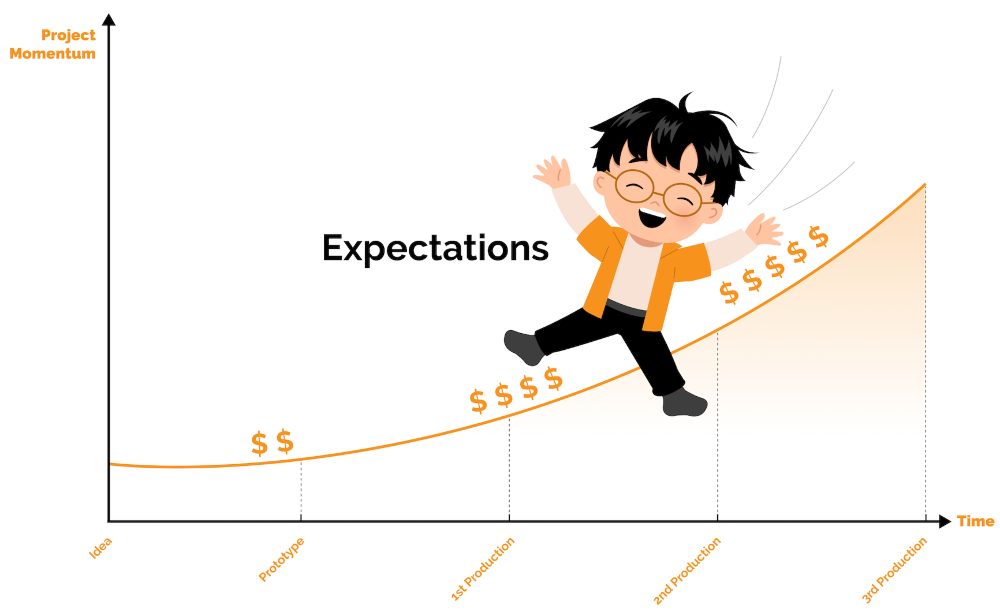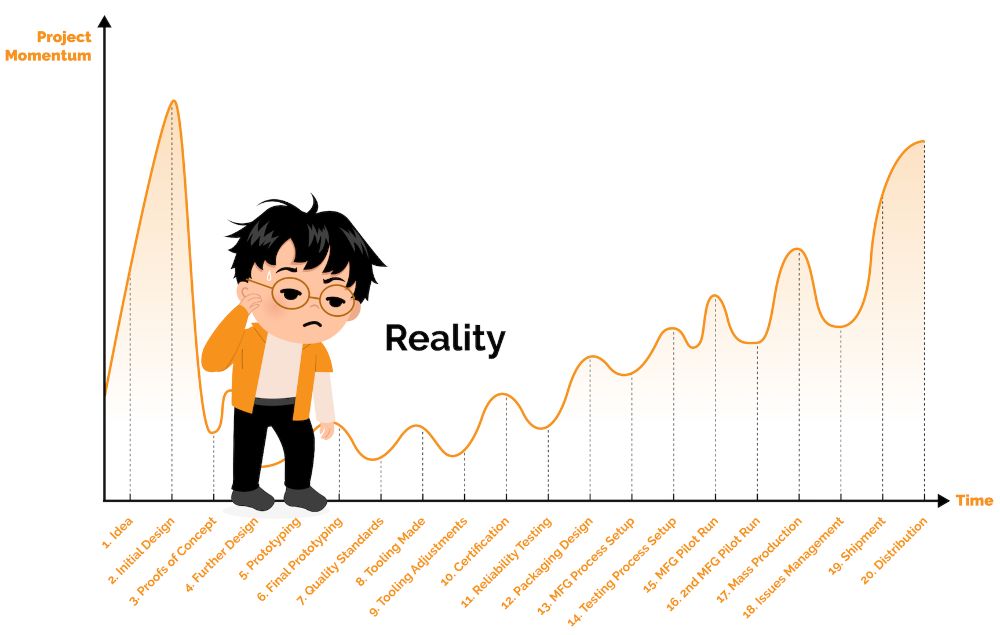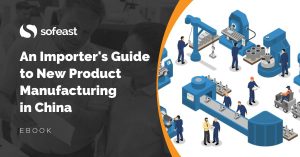Over the years, we have been talking to people who are planning to or are in the process of, developing a new product. And there is a very serious mismatch between expectations and reality during the new product development process.
So serious that people who are just starting on that path often cannot accept a realistic plan.
Unrealistic expectations
In their minds, there are only a few steps and a few success milestones. It looks a bit like this:

Harsh reality
However, here is the harsh reality of developing a new product and bring it to market:

Why is new product development taking so long?
Let’s take a new electronic product as an example. There are numerous stages of product development to go through.
First, there’s the need for funding. Investors want to see a functional prototype. Same thing with Kickstarter campaigns, with sales to distributors, and so on.
That means all the work until that point has to be self-funded. The industrial design (to get the initial ‘look’ of the product) may have to go through many iterations. And, if everything has to be done ‘on the cheap’, you will work with electric & mechanical engineers who are probably not the best and the fastest.
Since the product is innovative, it comes with its own challenges. The whole concept might evolve as it takes shape. It will keep evolving as the structural design is being done. That means a need for several versions of the design.
Some changes are needed when someone reviews the drawings. For instance, avoiding rounded shapes (not great for fitting square parts inside), improving the airflow in order to avoid fans, and so on and so forth.
In most cases, several prototypes have to be built. The first one is too “crude”, and it is not intended to be approved in full. But it calls for some adjustments, and so does the second build. Sometimes there is a need for 3, 4, 5, or more versions.
The electronic designers might first want to prepare for a functional demo in order to validate the product’s value in the eyes of target customers and/or satisfy investors. They might program an Arduino module with an LCD screen. And then, most of the work of that “demo prototype” cannot be reused as a custom PCB has to be designed and new components have to be picked. It is not linear.
More challenges often appear as the product design (mechanical, electronic, firmware, app…) is getting finalized. The last 10% can take over 50% of the work.
Getting to a great product design can take a lot of time and effort
We often tell our clients this.
Remember, the Dyson vacuum cleaner we know today went through 5,000 prototypes before its version 1.0 was approved for manufacturing.
For a relatively unique and complex product, it is pretty common for the development to take 3 months or more of intense work. Sometimes it is 9 to 12 months. And sometimes many years, for the most challenging products.
So, product development is over… but you are not going into production, yet!
Many companies think they have arrived when they have a prototype they like. And many suppliers, especially in China, make the path seem much easier than it is.
If you haven’t defined a quality standard, do you really want to go into production? How will the manufacturer know what is important to you, and how will you ensure they do a good job?
And, if you have developed an electro-mechanical product, will the manufacturer need to have custom-developed testing stations on the lines? That might take weeks.
Similarly, if your product needs tooling to be fabricated (for example for a custom-designed plastic enclosure), that will add about 30-45 days (including adjustments) to the schedule.
Once tooling is approved and some parts have been made, you can finally have samples that fully represent what will come out of mass production. That’s the time to apply for certifications (e.g. FCC, CE…) if needed. And that’s the time for final pre-production reliability testing, to confirm the product will not fail too easily or too early.
The fabrication of custom parts, and the assembly, have to be validated in pilot run(s), Otherwise, some issues might appear at the worst moment and lead to poor quality, extra costs, and long delays.
And, if there is a user-facing app that interacts with your server and represents a lot of software development work, you have to ensure your version 1.0 is ready and tested by then. We have seen projects that lost a few weeks because of refactoring that couldn’t wait.
Now your contract manufacturer or OEM supplier is ready, finally. Maybe you should still run a checklist on their degree of readiness. Maybe there are issues, and more time will be consumed.
Finally, everything is ready for production. Count one more month!
Once everything has been confirmed, the components & materials have to be ordered in the quantity needed for the first production batch. The main steps are:
- Procuring the parts (I am assuming contracts have already been signed with the suppliers, standards have been set, etc.)
- Receiving the parts and do incoming QC (let’s assume there are no major issues)
- Assemble, test, get feedback from the customer if there are imperfections, pack etc. (let’s again assume there are no issues)
- Book space for shipment, which hasn’t been an easy task in 2020 or 2021 so far
Do you see the potential for mishaps? You might want to include some extra time in your schedule to address them.
In summary…
To sum up, new product manufacturing is not simple, not easy, and full of risks. There is, more or less, a roadmap, based on past experiences with products in the same general category. If you are starting to design a new product, you need to talk to people who have worked on many projects that have similarities with yours. You need to plan ahead accordingly. Being over-optimistic will not help you.
Are you designing, or developing a new product that will be manufactured in China?
Sofeast has created An Importer’s Guide to New Product Manufacturing in China for entrepreneurs, hardware startups, and SMEs which gives you advance warning about the 3 most common pitfalls that can catch you out, and the best practices that the ‘large companies’ follow that YOU can adopt for a successful project.
It includes:
- The 3 deadly mistakes that will hurt your ability to manufacture a new product in China effectively
- Assessing if you’re China-ready
- How to define an informed strategy and a realistic plan
- How to structure your supply chain on a solid foundation
- How to set the right expectations from the start
- How to get the design and engineering right
Just hit the button below to get your copy (please note, this will direct you to my company Sofeast.com):


